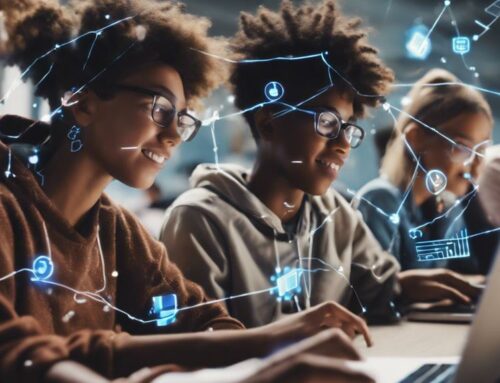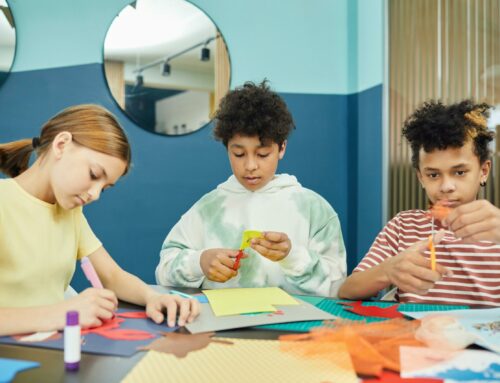For most of the United States, online learning became a new normal in 2020 with the start of the COVID-19 pandemic. Many schools were forced to close due to the spread of this highly contagious virus, relying on online classrooms instead. Students had to adapt to a new way of learning while also adjusting to the world’s rapidly changing circumstances. The abrupt transition from in-person learning to virtual learning in March of 2020 resulted in many obstacles. For many students, this unfamiliar learning style was a tricky transition and they had to adapt to this major change in their lives.
Challenges of Online Classrooms (and Their Solutions)
Distractions
One challenge many students have faced with learning in online classrooms is dealing with distractions at home. During the pandemic, many siblings and parents were also working from home – which resulted in a multitude of diversions. Distractions can pull a student’s attention away from their school tasks and lead to them missing out on important information. However, there are ways to help minimize disturbances at home and to enhance students’ learning. One solution is to create a dedicated workspace for online learning.
Having a specific location for learning allows students to focus better and separate their learning space from the rest of their homes. Make sure the space is equipped with all needed materials at hand, such as writing utensils and device chargers. Another solution is to provide students with noise-canceling headphones, which will minimize the potential of sound distractions while improving the quality of the sound coming from the student’s laptop or tablet. Providing students with the tools they need to minimize disturbances can set them up for success with learning virtually.
Social Interaction
Another problem that students are likely to face with learning online is diminished social interaction. The daily peer and adult socialization – both casual and formal – that occurs in a physical school setting is often missing in online classrooms. While some students may prefer this, others crave this social interaction to form meaningful connections with their friends and teachers. A solution to this problem is to schedule social activities with peers outside of the classroom.
Parents can organize video calls for students and some of their school friends to discuss readings, work on assignments, or even just socialize. Now that public locations have opened back up, scheduling in-person meet-ups with friends is a possibility. Places like the Chicago Children’s Museum, KidZania in Dallas, and the Houston Museum of Natural Science are great places for students to socialize with their peers. This supplemental socialization offers children the opportunity to practice vital soft skills, like leadership, conflict resolution, and active listening.
One-on-one assistance
Another problem with mainstream remote schooling is that many students may struggle with the lack of individualized communication with their teachers. A large online classroom is not as conducive to one-on-one interactions between the educator and each student. Therefore, the student-teacher relationship may not be as strong and the teacher might not be aware of all of the student’s unique needs and concerns.
A solution to this is for parents to help their children schedule personal meetings with their teachers to discuss topics such as expectations and areas of difficulty. Another solution is to seek out sources for smaller group remote learning opportunities, such as with a homeschooling group or a Learning Pod. Implementing these strategies can supplement a student’s learning with a more individualized focus on the student.
Benefits of Online Learning
Convenience
Although students may experience initial challenges adjusting to learning in an online environment, there are countless benefits that may make it worth the transition. One major positive outcome of online learning is convenience. For many students, minimizing the travel to a physical classroom is an amazing benefit of online learning. Without the time needed to travel to school, students can use this time in many more useful ways. For example, an extra 30 minutes of sleep could significantly improve a student’s mood and functioning. Students can also have extra time to eat breakfast, socialize with family members, and relax before joining their online classroom. Time is valuable, and reducing time wasted commuting allows the opportunity to use that time more wisely and effectively.
Equitable Resources
Another positive aspect of virtual learning is how it has made access to quality education resources more equitable. With the ability to access a vast amount of material online, quality learning is at the fingertips of students all over. For instance, almost anyone can stream a virtual lecture from an expert, there are many great free or low-cost adaptive learning apps, and most libraries have complementary eBooks available. With the wealth of available online learning resources, individuals have more opportunities to learn in more accessible, personalized, and efficient ways.
Reduced Social Anxiety
An additional benefit of virtual learning for some students is that there is a reduction in social anxiety while learning in the comfort of one’s home. For some students, going to an in-person classroom may be very anxiety-inducing. There are plenty of stressors that may accompany learning in an in-person setting, which includes bullying, social pressures from peers, and academic hardships. These worries can be overwhelming and negatively affect a student’s learning. They may interfere with a student’s ability to pay attention in class and may reduce their motivation to learn. For these students, learning online may be more comfortable and enjoyable without these pressures from peers and stressors from the social aspect of school. Learning in a stress-free environment can allow them to focus more on learning!
Conclusion
A concern parents may have regarding their students’ education is whether or not they are learning effectively in a virtual classroom setting. Fortunately, parents can assist their children by providing supplemental opportunities and resources to help them learn remotely. One proven-effective way that parents can aid their children’s learning in a personalized way is to hire a tutor. WorldWise Tutoring offers high-quality, online and in-person tutoring in the comfort of your own home. WorldWise tutors help students of all ages and all abilities in all subjects. Hire a tutor today!







